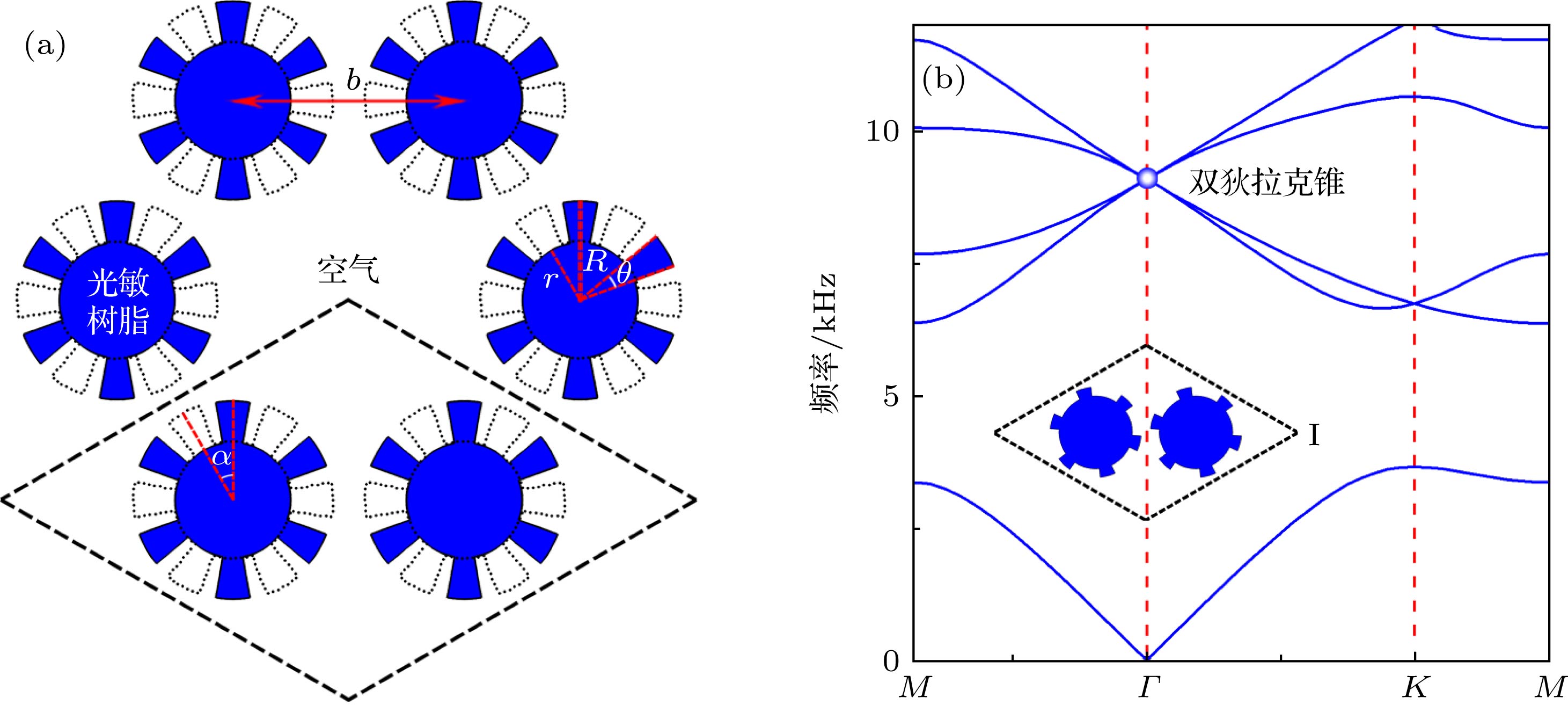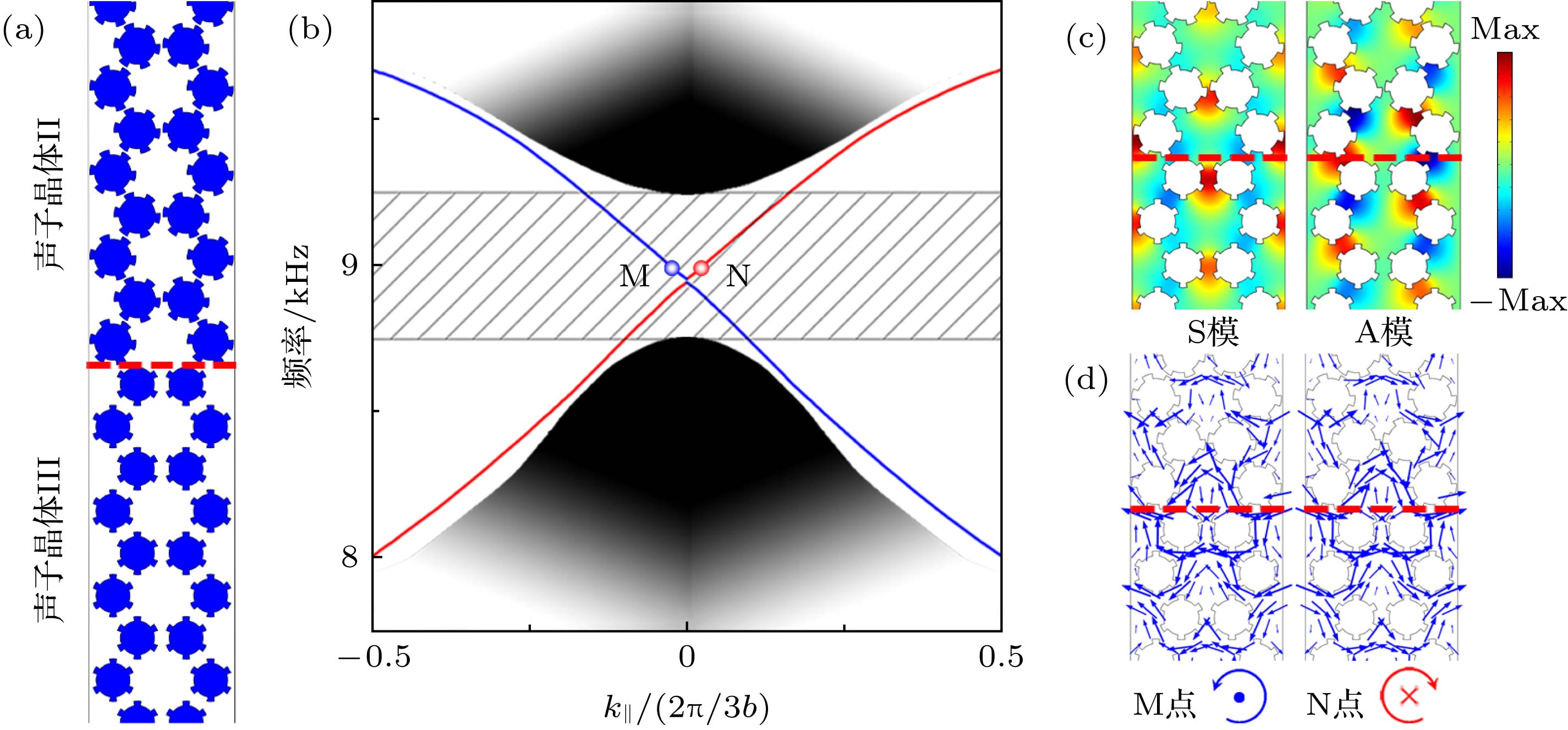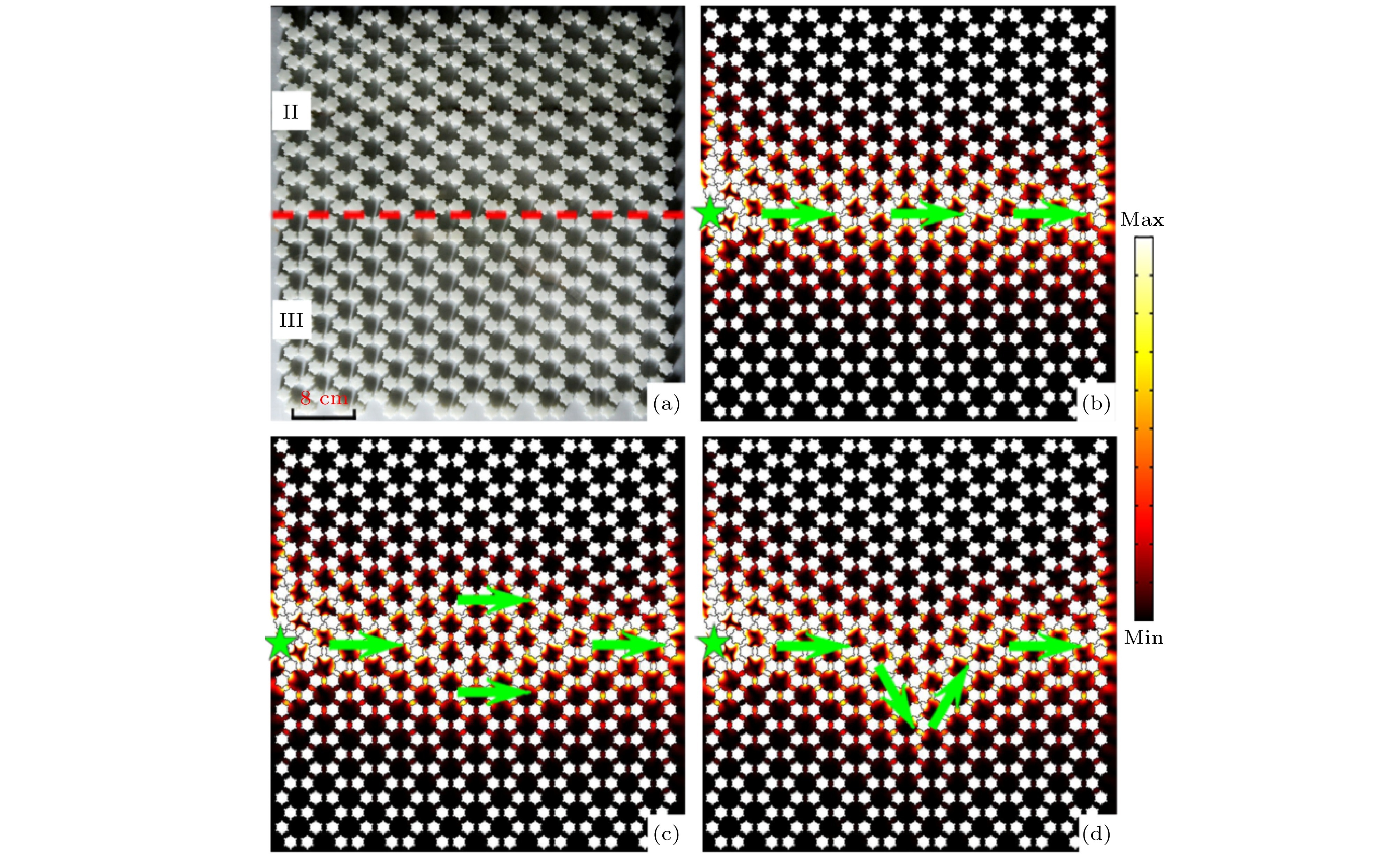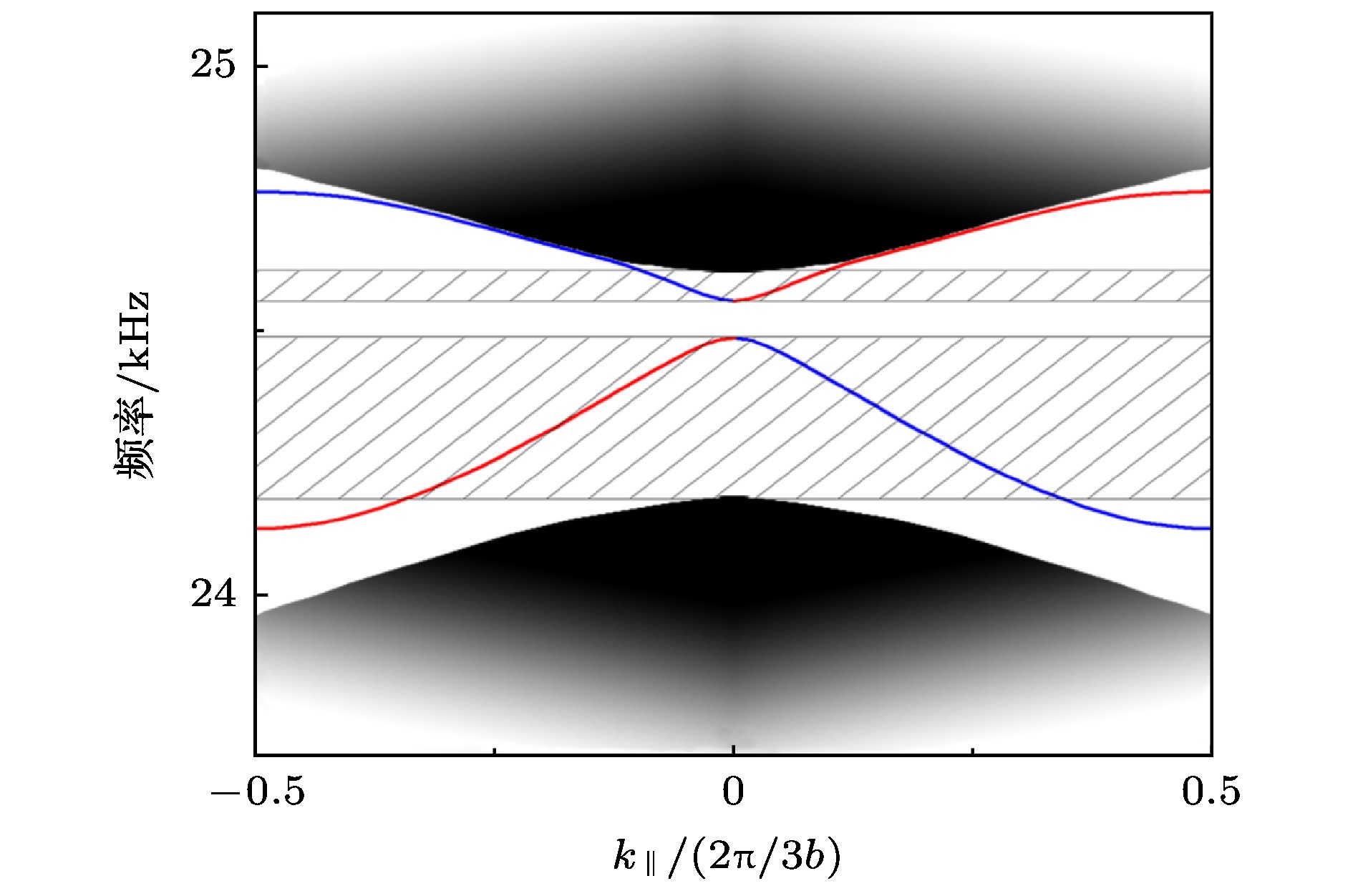-
Based on honeycomb-lattice sonic crystals with gear-like scatterers, we study and design a pseudospin-dependent dual-band acoustic topological insulator. Compared with cylindrical scatterers with only a single tunable structure parameter (radius), there exist four tunable parameters for the gear scatterer, which enables the sonic crystal to realize four-fold accidental degeneracy at two different frequencies simultaneously. By changing structure parameters of the gear-like scatterers, we can obtain topological phase transitions between two sonic crystals. Based on this, we design acoustic topological waveguides based on two honeycomb-lattice sonic crystals with different topological phases, and introduce two kinds of defects (a lattice disorder and a bend) into the topological waveguide near the domain wall. Numerical simulations show that pseudospin edge states almost immune to two types of defects and can pass through the topological waveguides with negligible backscatterings. Compared with the results for the topological waveguide without defects, the measured transmission spectra are almost unchanged with the two types of defects, which further experimentally verify the robustness of pseudospin-dependent edge states. Additionally, by keeping the structure of the sonic crystals unchanged, we can also obtain another four-fold accidental degenerate Dirac point and the corresponding topological sound phase transitions in the high-frequency region. The simulations show that there also exists a pair of edge states in the overlapped bulk bandgap of the two sonic crystals in the high-frequency region. It is worth noting that the tiny gap between two edge states is larger than that in the low-frequency region, which may arise from the greater difference between the distributions of pressure eigenfunction of two sonic crystals. The proposed dual-band acoustic topology insulator has potential applications in multi-band sound communication and sound information processing.
-
Keywords:
- sonic crystal /
- Dirac point /
- topological insulator /
- dual-band
[1] Yang Z J, Gao F, Shi X, Lin X, Gao Z, Chong Y D, Zhang B L 2015 Phys. Rev. Lett. 114 114301
 Google Scholar
Google Scholar
[2] Khanikaev A B, Fleury R, Mousavi S H, Alù A 2015 Nat. Commun. 6 8260
 Google Scholar
Google Scholar
[3] Ni X, He C, Sun X C, Liu X P, Lu M H, Feng L, Chen Y F 2015 New J. Phys. 17 053016
 Google Scholar
Google Scholar
[4] Chen Z G, Wu Y 2016 Phys. Rev. Appl. 5 054021
 Google Scholar
Google Scholar
[5] Ding Y J, Peng Y G, Zhu Y F, Fan X D, Yang J, Liang B, Zhu X F, Wan X G, Cheng J C 2019 Phys. Rev. Lett. 122 014302
 Google Scholar
Google Scholar
[6] Fleury R, Khanikaev A B, Alù A 2016 Nat. Commun. 7 11744
 Google Scholar
Google Scholar
[7] He C, Li Z, Ni X, Sun X C, Yu S Y, Lu M H, Liu X P, Chen Y F 2016 Appl. Phys. Lett. 108 031904
 Google Scholar
Google Scholar
[8] Peng Y G, Qin C Z, Zhao D G, Shen Y X, Xu X Y, Bao M, Han J, Zhu X F 2016 Nat. Commun. 7 13368
 Google Scholar
Google Scholar
[9] Wei Q, Tian Y, Zuo S Y, Cheng Y, Liu X J 2017 Phys. Rev. B 95 094305
 Google Scholar
Google Scholar
[10] Lu J Y, Qiu C Y, Ye L P, Fan X Y, Ke M Z, Zhang F, Liu Z Y 2017 Nat. Phys. 13 369
 Google Scholar
Google Scholar
[11] Xia B Z, Liu T T, Huang G L, Dai H Q, Jiao J R, Zang X G, Yu D J, Zheng S J, Liu J 2017 Phys. Rev. B 96 094106
 Google Scholar
Google Scholar
[12] Wen X H, Qiu C Y, Lu J Y, He H L, Ke M Z, Liu Z Y 2018 J. Appl. Phys. 123 091703
 Google Scholar
Google Scholar
[13] Yang Y H, Yang Z J, Zhang B L 2018 J. Appl. Phys. 123 091713
 Google Scholar
Google Scholar
[14] Zhang Z W, Tian Y, Cheng Y, Wei Q, Liu X J, Christensen J 2018 Phys. Rev. Appl. 9 034032
 Google Scholar
Google Scholar
[15] Zhang Z W, Tian Y, Wang Y H, Gao, S X, Cheng Y, Liu X J, Christensen J 2018 Adv. Mater. 30 1803229
 Google Scholar
Google Scholar
[16] Lu J Y, Qiu C Y, Deng W Y, Huang X Q, Li F, Zhang F, Chen S Q, Liu Z Y 2018 Phys. Rev. Lett. 120 116802
 Google Scholar
Google Scholar
[17] Mei J, Chen Z G, Wu Y 2016 Sci. Rep. 6 32752
 Google Scholar
Google Scholar
[18] Jia D, Sun H X, Yuan S Q, Zhang C, Liu X J 2019 Appl. Phys. Express 12 044003
 Google Scholar
Google Scholar
[19] He C, Ni X, Ge H, Sun X C, Chen Y B, Lu M H, Liu X P, Chen Y F 2016 Nat. Phys. 12 1124
 Google Scholar
Google Scholar
[20] Zhang Z W, Wei Q, Cheng Y, Zhang T, Wu D J, Liu X J 2017 Phys. Rev. Lett. 118 084303
 Google Scholar
Google Scholar
[21] Xia J P, Jia D, Sun H X, Yuan S Q, Ge Y, Si Q R, Liu X J 2018 Adv. Mater. 30 1805002
 Google Scholar
Google Scholar
[22] Jia D, Sun H.X, Xia J P, Yuan S Q, Liu X J, Zhang C 2018 New J. Phys 20 093027
 Google Scholar
Google Scholar
[23] 王健, 吴世巧, 梅军 2017 物理学报 66 224301
 Google Scholar
Google Scholar
Wang J, Wu S Q, Mei J 2017 Acta Phys. Sin. 66 224301
 Google Scholar
Google Scholar
[24] Li F, Huang X Q, Lu J Y, Ma J H, Liu Z Y 2018 Nat. Phys. 14 30
 Google Scholar
Google Scholar
[25] He H L, Qiu C Y, Ye L P, Cai X X, Fan X Y, Ke M Z, Zhang F, Liu Z Y 2018 Nature 560 61
 Google Scholar
Google Scholar
[26] Ge H, Ni X, Tian Y, Gupta S K, Lu M H, Lin X, Huang W D, Chan C T, Chen Y F 2018 Phys. Rev. Appl. 10 014017
 Google Scholar
Google Scholar
[27] Yang Y H, Sun H X, Xia J P, Xue H R, Gao Z, Ge Y, Jia D, Yuan S Q, Chong Y D, Zhang B L 2019 Nat. Phys. 15 645
 Google Scholar
Google Scholar
[28] Xue H R, Yang Y H, Gao F, Chong Y D, Zhang B L 2019 Nat. Mater. 18 108
 Google Scholar
Google Scholar
[29] Ni X, Weiner M, Alù A, Khanikaev A B 2019 Nat. Mater. 18 113
 Google Scholar
Google Scholar
[30] Zhang X J, Wang H X, Lin Z K, Tian Y, Xie B, Lu M H, Chen Y F, Jiang J H 2019 Nat. Phys. 15 582
 Google Scholar
Google Scholar
[31] Sun Y Y, Xia J P, Sun H X, Yuan S Q, Ge Y, Liu X J 2019 Adv.Sci. 6 1901307
 Google Scholar
Google Scholar
[32] Xia J P, Zhang X T, Sun H X, Yuan S Q, Qian J, Ge Y 2018 Phys. Rev. Appl. 10 014016
 Google Scholar
Google Scholar
[33] Huang Y L, Sun H X, Xia J P, Yuan S Q, Ding X L 2016 Appl. Phys. Lett. 109 013501
 Google Scholar
Google Scholar
[34] Sun H X, Yuan S Q, Zhang S Y 2015 Appl. Phys. Lett. 107 213505
 Google Scholar
Google Scholar
[35] Wu L H, Hu X 2015 Phys. Rev. Lett. 114 223901
 Google Scholar
Google Scholar
-
图 3 (a)声子晶体II与III组成的超原胞结构, 红虚线表示两种声子晶体之间的界面; (b)超原胞对应的色散关系; (c)超原胞的对称模S与反对称模A声压本征场分布(图(b)中N点, k|| = 0.05); (d)超原胞的边缘模式声能流场分布(图(b)中M点与N点, k|| = ± 0.05)
Fig. 3. (a) Schematic of a supercell composed of SC-II and SC-III. Red dashed line represents the domain wall between two SCs; (b) dispersion relation of the supercell; (c) simulated pressure eigenfunctions (S and A modes) of the supercell at point N (k|| = 0.05) in Fig. (b); (d) simulated acoustic energy flow for pseudospin-dependent edge modes at points M and N (k|| = ± 0.05) in Fig. (b).
图 4 (a)基于声子晶体II与III的声拓扑波导样品, 红虚线表示两种声子晶体的界面. 数值模拟频率为9.1 kHz (体带隙内)的声波通过三种类型的拓扑波导产生的声能量密度场分布, 三种拓扑波导分别对应(b)无缺陷, 含内置(c)无序与(d)弯曲缺陷. 绿色星与箭头分别表示声源位置和声传播方向
Fig. 4. (a) Photograph of a topological waveguide composed of SC-II and SC-III. Red dashed line represents the domain wall of two SCs. Simulated distributions of acoustic intensity field at 9.1 kHz (within bulk band gap) through topological waveguides with three different configurations, corresponding to (b) without defects, and with (c) a disorder and (d) a bend. Green star and arrows represent source positions and propagation directions.
图 6 声子晶体(a) I, (b) II和(c) III在高频区间(24.44 kHz左右)的色散关系; (d)高频区间对应的声子晶体II与III在布里渊区中心的本征声压场分布
Fig. 6. Dispersion relations of (a) SC-I, (b) SC-II and (c) SC-III in high-frequency region (around 24.44 kHz); (d) distributions of pressure field for eigenmodes at Brillouin zone center of SC-II and SC-III in high-frequency region.
-
[1] Yang Z J, Gao F, Shi X, Lin X, Gao Z, Chong Y D, Zhang B L 2015 Phys. Rev. Lett. 114 114301
 Google Scholar
Google Scholar
[2] Khanikaev A B, Fleury R, Mousavi S H, Alù A 2015 Nat. Commun. 6 8260
 Google Scholar
Google Scholar
[3] Ni X, He C, Sun X C, Liu X P, Lu M H, Feng L, Chen Y F 2015 New J. Phys. 17 053016
 Google Scholar
Google Scholar
[4] Chen Z G, Wu Y 2016 Phys. Rev. Appl. 5 054021
 Google Scholar
Google Scholar
[5] Ding Y J, Peng Y G, Zhu Y F, Fan X D, Yang J, Liang B, Zhu X F, Wan X G, Cheng J C 2019 Phys. Rev. Lett. 122 014302
 Google Scholar
Google Scholar
[6] Fleury R, Khanikaev A B, Alù A 2016 Nat. Commun. 7 11744
 Google Scholar
Google Scholar
[7] He C, Li Z, Ni X, Sun X C, Yu S Y, Lu M H, Liu X P, Chen Y F 2016 Appl. Phys. Lett. 108 031904
 Google Scholar
Google Scholar
[8] Peng Y G, Qin C Z, Zhao D G, Shen Y X, Xu X Y, Bao M, Han J, Zhu X F 2016 Nat. Commun. 7 13368
 Google Scholar
Google Scholar
[9] Wei Q, Tian Y, Zuo S Y, Cheng Y, Liu X J 2017 Phys. Rev. B 95 094305
 Google Scholar
Google Scholar
[10] Lu J Y, Qiu C Y, Ye L P, Fan X Y, Ke M Z, Zhang F, Liu Z Y 2017 Nat. Phys. 13 369
 Google Scholar
Google Scholar
[11] Xia B Z, Liu T T, Huang G L, Dai H Q, Jiao J R, Zang X G, Yu D J, Zheng S J, Liu J 2017 Phys. Rev. B 96 094106
 Google Scholar
Google Scholar
[12] Wen X H, Qiu C Y, Lu J Y, He H L, Ke M Z, Liu Z Y 2018 J. Appl. Phys. 123 091703
 Google Scholar
Google Scholar
[13] Yang Y H, Yang Z J, Zhang B L 2018 J. Appl. Phys. 123 091713
 Google Scholar
Google Scholar
[14] Zhang Z W, Tian Y, Cheng Y, Wei Q, Liu X J, Christensen J 2018 Phys. Rev. Appl. 9 034032
 Google Scholar
Google Scholar
[15] Zhang Z W, Tian Y, Wang Y H, Gao, S X, Cheng Y, Liu X J, Christensen J 2018 Adv. Mater. 30 1803229
 Google Scholar
Google Scholar
[16] Lu J Y, Qiu C Y, Deng W Y, Huang X Q, Li F, Zhang F, Chen S Q, Liu Z Y 2018 Phys. Rev. Lett. 120 116802
 Google Scholar
Google Scholar
[17] Mei J, Chen Z G, Wu Y 2016 Sci. Rep. 6 32752
 Google Scholar
Google Scholar
[18] Jia D, Sun H X, Yuan S Q, Zhang C, Liu X J 2019 Appl. Phys. Express 12 044003
 Google Scholar
Google Scholar
[19] He C, Ni X, Ge H, Sun X C, Chen Y B, Lu M H, Liu X P, Chen Y F 2016 Nat. Phys. 12 1124
 Google Scholar
Google Scholar
[20] Zhang Z W, Wei Q, Cheng Y, Zhang T, Wu D J, Liu X J 2017 Phys. Rev. Lett. 118 084303
 Google Scholar
Google Scholar
[21] Xia J P, Jia D, Sun H X, Yuan S Q, Ge Y, Si Q R, Liu X J 2018 Adv. Mater. 30 1805002
 Google Scholar
Google Scholar
[22] Jia D, Sun H.X, Xia J P, Yuan S Q, Liu X J, Zhang C 2018 New J. Phys 20 093027
 Google Scholar
Google Scholar
[23] 王健, 吴世巧, 梅军 2017 物理学报 66 224301
 Google Scholar
Google Scholar
Wang J, Wu S Q, Mei J 2017 Acta Phys. Sin. 66 224301
 Google Scholar
Google Scholar
[24] Li F, Huang X Q, Lu J Y, Ma J H, Liu Z Y 2018 Nat. Phys. 14 30
 Google Scholar
Google Scholar
[25] He H L, Qiu C Y, Ye L P, Cai X X, Fan X Y, Ke M Z, Zhang F, Liu Z Y 2018 Nature 560 61
 Google Scholar
Google Scholar
[26] Ge H, Ni X, Tian Y, Gupta S K, Lu M H, Lin X, Huang W D, Chan C T, Chen Y F 2018 Phys. Rev. Appl. 10 014017
 Google Scholar
Google Scholar
[27] Yang Y H, Sun H X, Xia J P, Xue H R, Gao Z, Ge Y, Jia D, Yuan S Q, Chong Y D, Zhang B L 2019 Nat. Phys. 15 645
 Google Scholar
Google Scholar
[28] Xue H R, Yang Y H, Gao F, Chong Y D, Zhang B L 2019 Nat. Mater. 18 108
 Google Scholar
Google Scholar
[29] Ni X, Weiner M, Alù A, Khanikaev A B 2019 Nat. Mater. 18 113
 Google Scholar
Google Scholar
[30] Zhang X J, Wang H X, Lin Z K, Tian Y, Xie B, Lu M H, Chen Y F, Jiang J H 2019 Nat. Phys. 15 582
 Google Scholar
Google Scholar
[31] Sun Y Y, Xia J P, Sun H X, Yuan S Q, Ge Y, Liu X J 2019 Adv.Sci. 6 1901307
 Google Scholar
Google Scholar
[32] Xia J P, Zhang X T, Sun H X, Yuan S Q, Qian J, Ge Y 2018 Phys. Rev. Appl. 10 014016
 Google Scholar
Google Scholar
[33] Huang Y L, Sun H X, Xia J P, Yuan S Q, Ding X L 2016 Appl. Phys. Lett. 109 013501
 Google Scholar
Google Scholar
[34] Sun H X, Yuan S Q, Zhang S Y 2015 Appl. Phys. Lett. 107 213505
 Google Scholar
Google Scholar
[35] Wu L H, Hu X 2015 Phys. Rev. Lett. 114 223901
 Google Scholar
Google Scholar
计量
- 文章访问数: 17050
- PDF下载量: 463
- 被引次数: 0














 下载:
下载:






